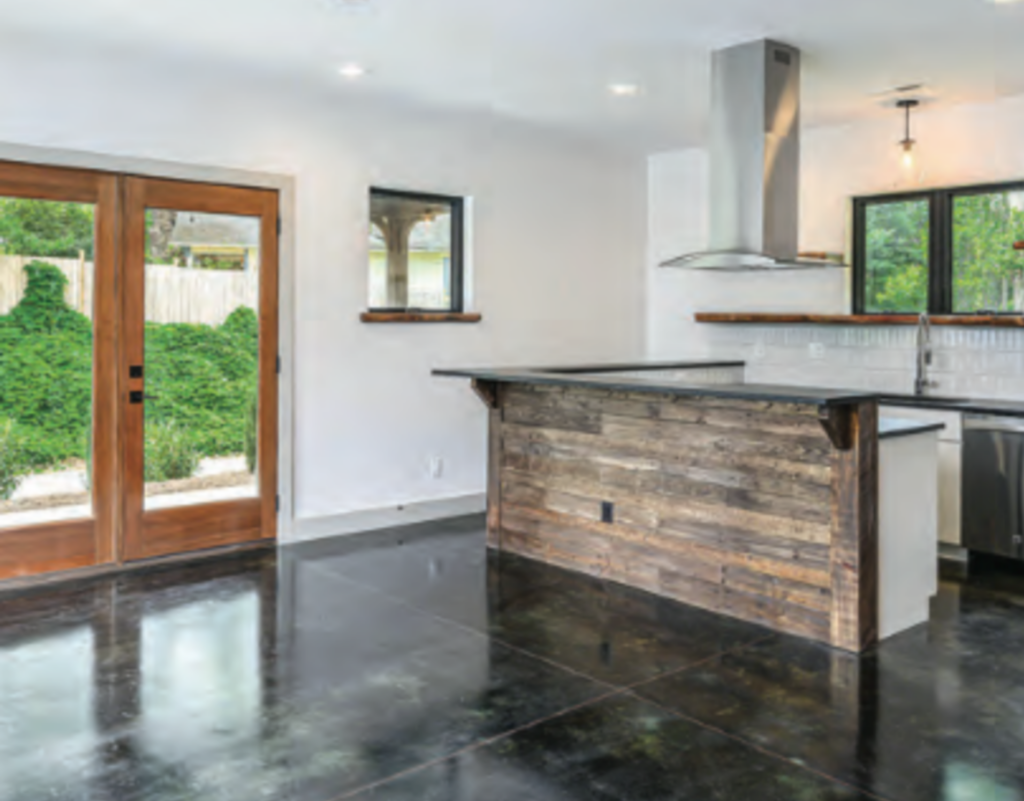Builder Gus Katsigiannis of Familia Enterprises partnered with recurring clients Mark McCraw and Beth Lassiter to build his first net-zero home in the Falconhurst neighborhood of Asheville.
The team first met while Familia was renovating the clients’ 100-year-old house. Their relationship deepened when Familia built a sustainable home for Lassiter’s mother that achieved Green Built Homes’ gold level of certification. The team’s next collaboration was to embark on building this net-zero home on spec as a joint investment project.
“We owe it to the wonderful world we live in to not to set it on fire,” Lassiter said. “That’s how the future should work — to put houses out there that are beautiful, easy to live in, and make people happy, but that also honor the earth.”
A passive solar design was purchased from another local builder and modified to meet the unique needs of this particular project. As with most passive solar designs, the plan would work with the home’s windows and solar energy to extract heat from the sun. The layout of the site was also integral to the design.
“The orientation of the lot was perfect for this project,” Katsigiannis said. “It offers ideal southern exposure.”
The southern exposure and a unique type of window work in conjunction with a heat sink to absorb solar energy. The team installed an 8-inch thick concrete slab on the first floor and stained it a dark color. When the sun shines during the winter, it hits the dark floor, which captures the heat and energy from the sun then releases it slowly to heat the home.
“To work correctly, this type of energy sourcing is a mix of lot layout direction, using a heat sink of some kind, window placement, overhang placement, and installing the correct glass that allows the heat to come through and heat that pad,” Katsigiannis said. “It’s pretty cool and it’s free.”
Additionally, you can control the amount of heat with creative use of automated blinds and curtains. These specially designed window hangings work with the timing and angle of the sun, opening and closing as needed to allow for maximum heat capture .
According to the homeowners, if the sun is out, the heat never kicks on, even during winter months when outside temperatures approach freezing.
“It’s basic and primitive in nature,” Katsigiannis said. “I appreciate efficiency, and I don’t want to leave the earth worse than I found it. My goal is to build homes that require minimal maintenance. I want the house to look the same in 25 years as it did the day we finished it.”
Along with the heat pad inside, the home has an active solar system on the exterior with 6 kW of panels on the roof. Other than a gas stovetop, the team selected all electric appliances to leverage power from the solar panels.
Lassiter served as a project manager during the build, working behind the scenes on design tasks and product selection.
“At every step, we were intentional about sustainability and sourcing local products,” Lassiter said.
Other green-building elements of the project included an on-demand water heater, low-flow faucets and showerheads, and low-VOC interior paint and finishes on the flooring. The cabinetry is made of regionally sourced green-rated plywood. Many materials were procured from local sources including live-edge wood on the windowsills and in the kitchen.
The team focused on outdoor space as well to ensure the homeowners could enjoy the property’s natural features. A covered porch was built on the side of the house adjacent to the kitchen and dining room. Native plants and fruit-bearing shrubs were added to the landscaping.
“We tried to create a combination of beauty and privacy,” Katsigiannis said. “You can still see your neighbors, but we tried to block off the street as much as possible.”
The exterior of the house is a combination of rough-cut pine timbers and poplar bark, all regionally sourced. A permeable driveway and sidewalk were installed to better manage the water coming off the house. The team dug a hole and lined it with rock to create a catch basin, which allows the water more time to seep into the earth.
This 1,750 square-foot net zero house ultimately earned Green Built Homes’ Platinum Net Zero level of certification in the summer of 2020, with a Home Energy Rating System (HERS) Score of -6. When the build was complete, a couple from Boston purchased the home.
“Quality fit and finish are big for me,” Katsigiannis said. “It’s all about my son driving by this house with his kids when I’m gone and saying, ‘Hey, my dad built that house. Look how good it looks.’ That’s true pride in what I do.”
Susanna Shetley is a reporter at Smoky Mountain News, with which Green Built Alliance partners to publish its annual Green Building Directory.
You can also view this article as it was originally published on page 24 of the 2021-22 edition of the directory.


